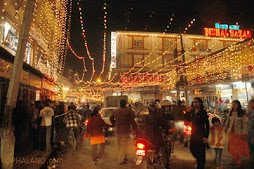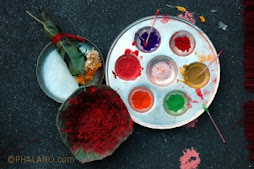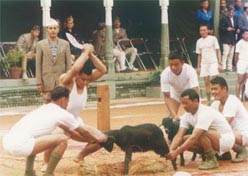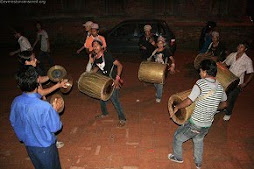Another interesting aspect of Dashain was the various animal sacrifices offered to goddess Bhavani. The Brahmin hindus mostly preferred to sacrifice a goat, whereas the Newar hindus sacrificed either chicken/duck or buffalo. The ritual of sacrifice was elaborate and often planned days or even weeks in advance. Individual families would spend several days searching for the perfect animal in the livestock market. In our case, the search party involved mostly my grandfather, accompanied by his grandchildren (myself and my cousins), and occasionally by my uncle too. So we would visit the livestock market in Tundikhel (this was the 70s) looking for a young, healthy goat that had no obvious marks (bruises, cuts etc.) on its body and had thick and shiny black fur. Only when black goats were not available we would select a brown or a white goat. I don’t think we ever had to select a goat that was not black. This sometimes meant paying a premium price for the goat, as every family wanted the sacrificial goat to be as perfect as it could be.
While visiting the livestock market was fun, the whole affair of goat selection and the subsequent sacrifice was horrible for the poor animal. Once the selection was determined, my grandfather and my uncle negotiated the price with the seller and this sometimes required a mastery of the art of negotiation. You pretended that you are walking away from the sale looking for another seller, sometimes you argued why the goat was not worth its price by drawing the owner’s attention to the physical defects of the animal. Not that the animal really had a defect, it’s just that you needed something to be critical about in the hopes that the seller would soften a little bit. During Dashain time it was often customary to buy a pair of goats, the young one (Boka in Nepali, male, not neutered) would be sacrificed at the temple, the matured one (Khasi, male, neutered) would be slaughtered at the neighborhood butcher’s shop. The goats were tied with a short rope around their neck, we would hold the rope and let them follow us. If the goat was too stubborn to leave its other companions at the market, one of us got behind it and hit its hind legs with a small stick or with our palm. The journey home would often be very interesting. If taxis were available, we would take the taxi and put the goat in the trunk. But if we had to walk home, this would entail a very careful navigation of the streets through Asan and Chettrapati, which were crowded with people shopping for Dashain. Sometimes the goat would set itself free from our hands and dart across the street, we had to run after it as fast as it could, as losing it meant not only a couple hundred rupees gone down the drain but also initiating the search all over again. Once home, we played with the goats feeding them grass or corn, and teasing and torturing by all means possible. Because we didn’t really have a place for the goat in our house, typically we bought the goats a day or two ahead of the sacrifice. I often wondered what the goats felt when they were separated from their family or companions, and when they had to walk through the busy street and tolerate the humiliation we inflicted upon them. One thing was sure, I did not want to be one of those poor goats, which was raised, and ironically, even loved just to be sacrificed to fulfill our religious practices and beliefs. Never did I question why the goats had to live and die that way, we were simply doing what everybody did in the name of celebrating Dashain.
On the fateful day (the eighth day or Ashtami), my uncle and I would bring the black goat to Shoba Bhagavati temple. The temple organizers always separated worshippers in three lines: male worshippers, female worshipper, and those with sacrificial animals. I have witnessed these sacrifices without any feelings of guilt, emotion or stress. I think I was inhumanely indifferent to the animal. The priest’s aide would grab the goat by its neck with his left hand, the knife on his right hand, his knee holding the lower part of the goat's body lest it sets itself free. He would then pierce the lower neck with the knife and run it across the neck, the blood that squeezed was offered to the goddess. After a while the goat would be silent, decapitated and ready to be put in a jute sack and carried home for butchering and then feasting. All this would occur in the early hours of the day, usually before six in the morning. The sacrifice, it was believed, would bring us happiness, peace and prosperity. At that time I had no doubts it brought us happiness – we would be feasting on delicious goat meat later during the day. About peace, I don’t know, I certainly thought that even the goat knew its fate as soon as it was brought before the goddess, and perhaps it felt an inner peace while accepting its impending fate. The strange thing was the goat never made any fuss (it did not yelp or made any noise) about being sacrificed even when it saw the priest’s aide and his sharp knife still dripping with fresh blood from previous sacrifice.
The following day (ninth day, Navami), we would bring the other goat to the butcher’s shop. If you did not rise up early (just before dawn), you would be so far behind the line that you would have to wait hours until your turn came. For that day the street would be the butcher’s shop, for he would build a makeshift stove on a street corner and place a big open-top pot of boiling water. The slaughter went something like this: the butcher asks his assistant to hold the goat’s horns with each hand, the owner of the goat holds the hind legs with both hands as some owners were too afraid to hold the horns lest the butcher misses his target, the butcher places a block of wood on the ground right below the goat’s neck. Once the goat is positioned, the butcher sprinkles some water on the goats head, if the goat shakes its head it is now auspicious to kill the goat, if it doesn’t, the butcher waits for a while and tries again. Once the goat is ready, the butcher positions himself perpendicular to the goat, brings his crescent-shaped khukuri (traditional Nepali knife made of iron) high above his head and then with one strong downward swing strikes the goat’s neck. The goat is now completely decapitated, the butcher rushes to hold the body and squeezes the blood into a pan. He then starts skinning, gutting, cleaning, cutting, etc. The goat would be ready as meat in less than an hour.
For some reasons, kids in my neighborhood were fascinated to see the killing, on occasions some people would walk around with their big khukuri volunteering to do the killing, sometimes the killer (if he was just a novice) will have to attempt more than once to finish a single job. This macabre affair was celebrated by young and adults alike, all in the name of religion and festival. I guess violence is an innate human character, the beast within us rises on such occasions, affirming our belief that we are the supreme animals, the conquerors. The goat becomes a mute victim, a silent witness to such barbaric acts. I am still puzzled why I and other kids my age (I was around ten years older at that time) were fascinated with such acts of cruelty inflicted upon the goat. Not that I had a violent attitude. The whole episode of goat sacrificing and butchering was somewhat reassuring to me that my fate would be different from that of the poor goat, though I can’t still figure out what was so reassuring about it. The goat was innocent looking, often pitifully tied next to the one that was being slaughtered, its sad eyes pleading for mercy. Silence blanketed the early morning atmosphere, broken only by the occasional crackling noise coming from the burning firewood, the occasional yelp of the goats, the whacking sound of the knife, and the chatter of the few people that were around to witness the cruetly. The silence seemed ungodly, the dawn prophetic.
Saturday, September 26, 2009
Subscribe to:
Post Comments (Atom)












































amazing post..
ReplyDeleteI know how difficult it is finding a good spot. I was in London a holiday last summer and it took me ages finding a good hotel at a good price.I think the only thing that has eased my process was LTM. I highly recommend them. You should try their website. I found a good London hotel...
http://www.lastminutetravel.com/Destination/London-Hotels.aspx